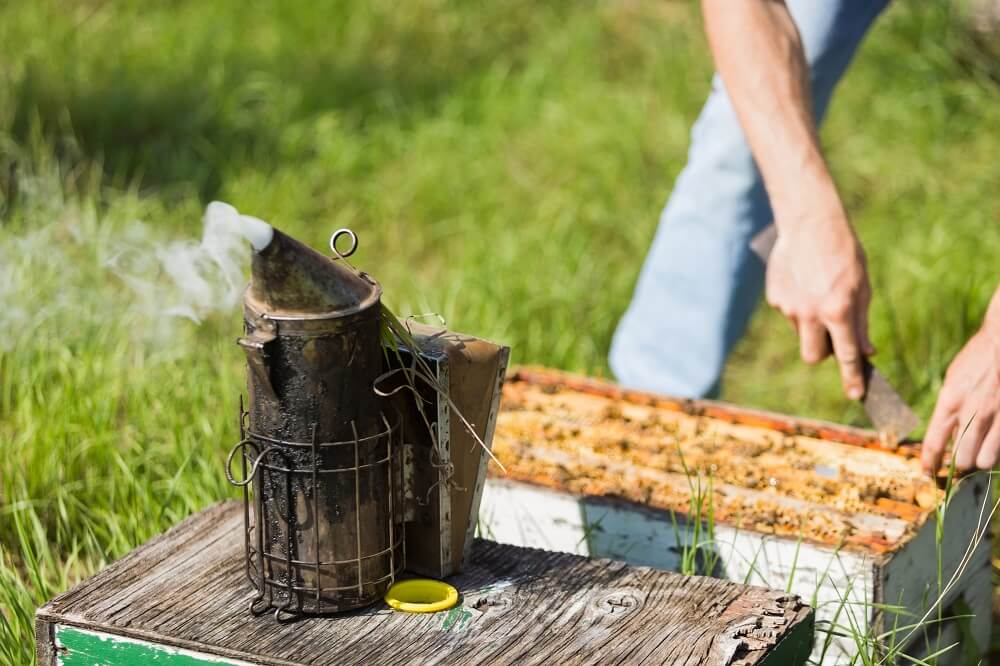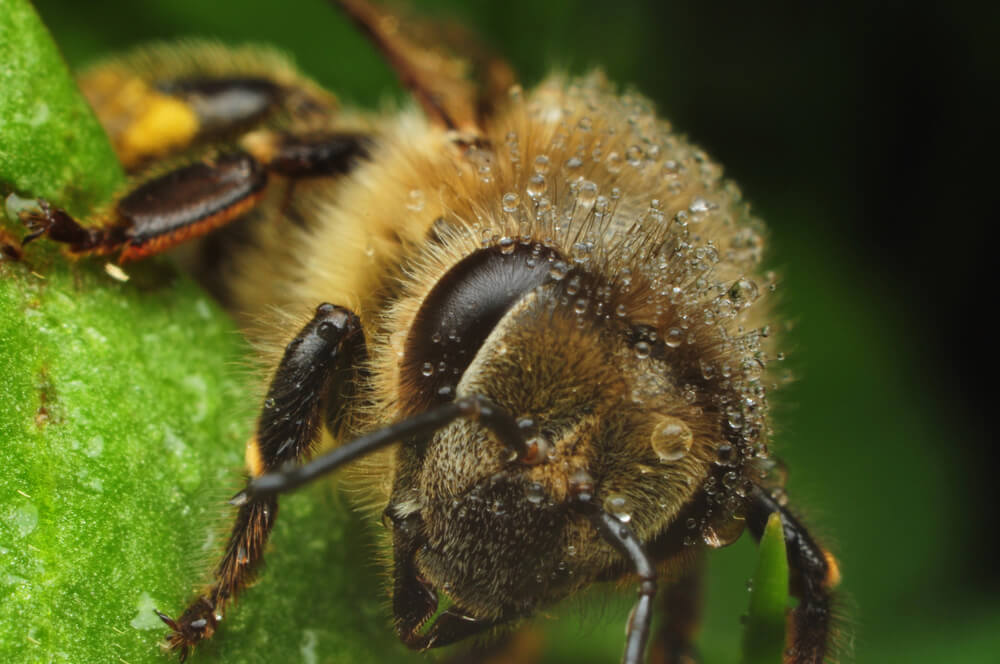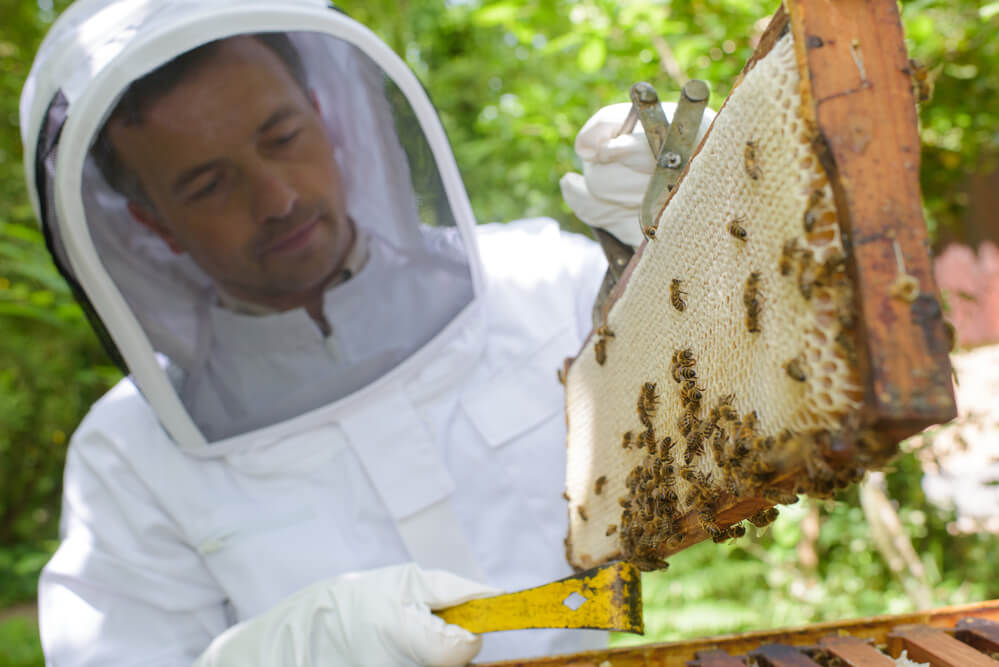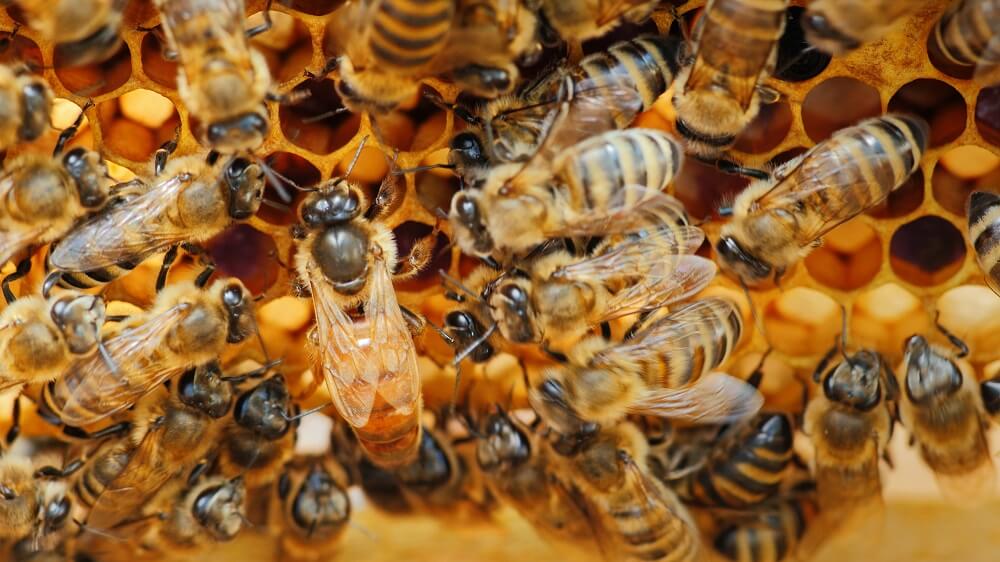Table of Contents:
What Do Beginner Beekeepers Need?
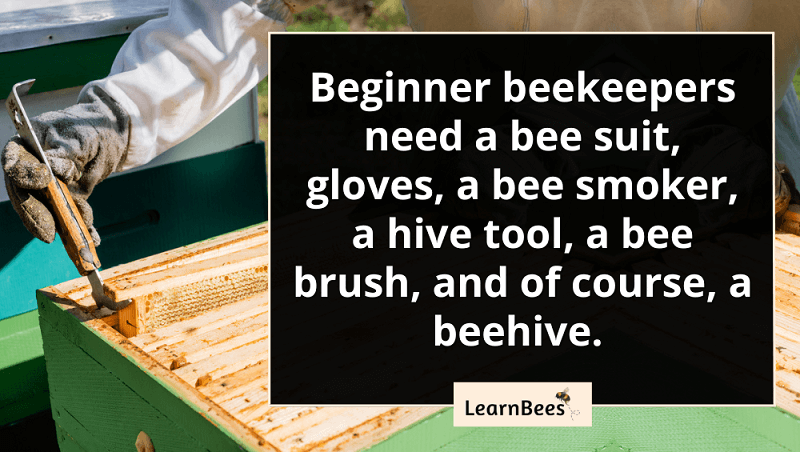
Simply put:
Beginner beekeepers need a bee suit, gloves, a bee smoker, a hive tool, a bee brush, and of course, a beehive.
But we shouldn’t get ahead of ourselves.
There’s something you should do first:
Learn as much as you can about honeybees before buying any piece of beekeeping equipment.
Read at least one book about honeybees. Watch YouTube videos of other beekeepers. Learn about which flowers you can plant to feed your bees. Talk to local beekeepers and ask questions.
These are the things that’ll make you a better beekeeper.
So, where do you begin?
We recommend starting with Dr. Seeley’s book, The Lives of Bees: The Untold Story of the Honey Bee in the Wild.
Dr. Seeley has dedicated his life to the study of bees. I don’t think there’s a single person on the planet who knows more about honeybees than Dr. Seeley.
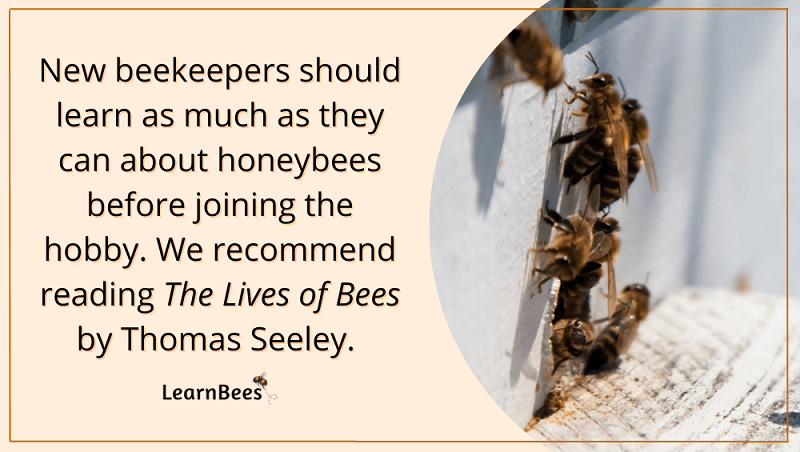
He’s the Horace White Professor of Biology at Cornell University. He’s authored several best-selling books about bees and their behavior. He also won the Humboldt Prize in Biology in 2001.
The man knows his stuff.
Every beekeeper – whether new or experienced – should read The Lives of Bees. This book sheds light on why managed bee colonies are in crisis and wild honeybee colonies thrive.
Dr. Seeley offers a new approach to beekeeping―Darwinian Beekeeping―which allows honeybees to use their survival skills to create solutions for their current challenges.
Thomas Seeley offers practical advice, such as:
- Beehives should be spaced as far apart as possible. This reduces the spread of diseases amongst colonies, which is a concern for beekeeping.
- Buy bees locally. This allows you to have bees adapted to your location, which is crucial.
- Keep bees in small hives. This mimics a bee’s natural behavior in the wild and reduces the risk of diseases and pests. Smaller colonies will swarm, but swarming is natural and promotes colony health.
Now that we’ve gotten that out of the way, let’s talk about what every beginner beekeeper needs.
Beekeeping Supply #1: The Hive
There are three main types of beehives: The Langstroth, the Top Bar, and the Warre.
The Langstroth hive is by far the most popular type of beehive. It consists of several boxes stacked on top of each other. Generally, this type of hive is recommended for beginners. The benefit of Langstroth hives is that they’re more affordable, and parts are widely available.
Additionally, since most beekeepers use Langstroth hives, you can seek help from local beekeepers if needed.
Beekeeping Supply #2: The Hive Stand
Your beehives should be off the ground to deter critters like ants, rodents, or other predators. You can buy a pre-made hive stand, or you can make your own using cinder blocks or wood.
Beekeeping Supply #3: The Bee Suit
Honeybees are more gentle than most people realize. That said, every beekeeper needs a good bee suit on hand.
The one thing to remember with bee suits is that you want well-ventilated ones.
You’ll be performing hive inspections during warm months. This means you’ll need a suit that allows air to flow in, so you’re not sweating bullets and miserable in the heat. We recommend Oz Armour’s bee suit for the best sting protection and ventilation.
Beekeeping Supply #4: Bee Gloves
Many experienced beekeepers don’t use gloves because they lose some sense of touch.
I get it.
But if you’re a beginner beekeeper, you should have a pair of gloves handy. If you later become comfortable with your bees and decide to go without gloves, then you can. But always begin with your safety in mind first.
These beekeeping gloves are soft and give you more flexibility for dexterity. The elastic fits snuggly, which is good because it prevents bees from flying into your gloves.
Beekeeping Supply #5: A Bee Smoker
A bee smoker is a tool beekeepers use to puff smoke onto their honeybees. Most beekeepers call them “smokers” for short.
Bee smokers work by calming the bees down so you can safely work around the hive. It masks the bee’s alarm pheromones that they produce when stressed. These pheromones alert the colony to danger and help them defend themselves.
Beekeeping Supply #6: A Hive Tool
The hive tool is a staple among beekeepers. It allows you to separate frames, remove burr comb, scrape propolis and excess wax, and loosen hive parts.
Beekeeping Supply #7: A Bee Brush
Bee brushes are soft brushes that gently sweep the honeybees from the comb. Bee brushes come in handy during hive inspections.
How Many Beehives Should a Beginner Start With?
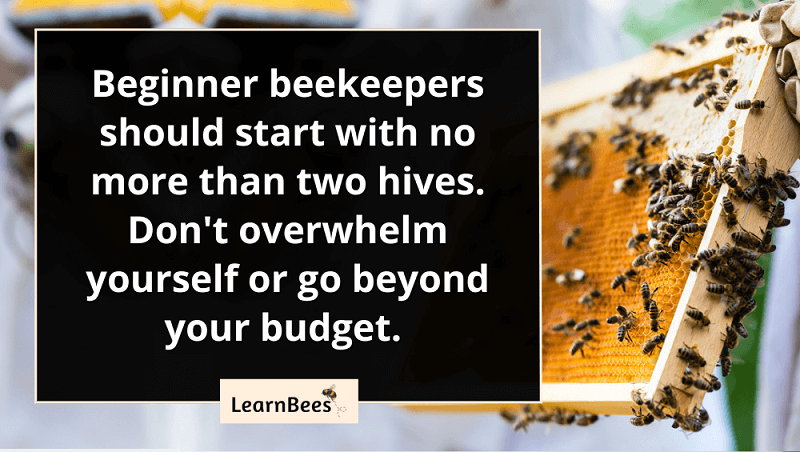
The general recommendation is that beginner beekeepers should start with two hives. If you have no experience with honeybees at all, then don’t buy more than two.
That said, you can buy just one hive if you want to. Don’t go beyond your budget. Plenty of beginner beekeepers start with one hive only.
However, there are a few pros to using two hives:
- If one of your hives becomes sick, you have a backup.
- If one hive is weak, you can use the stronger colony to strengthen them.
- You can compare the two hives side-by-side to look for differences.
- Two hives produce more honey than one hive (assuming they both survive)
Of course, starting with two hives also has its downsides. The biggest one is the increased cost. If you’re on a budget, then it might be better to start with just one hive.
And keep in mind:
You probably won’t harvest honey from your hives in the first year. Your honeybees will need their first year to establish their colony and build honey stores.
What is the Best Month to Start Beekeeping?
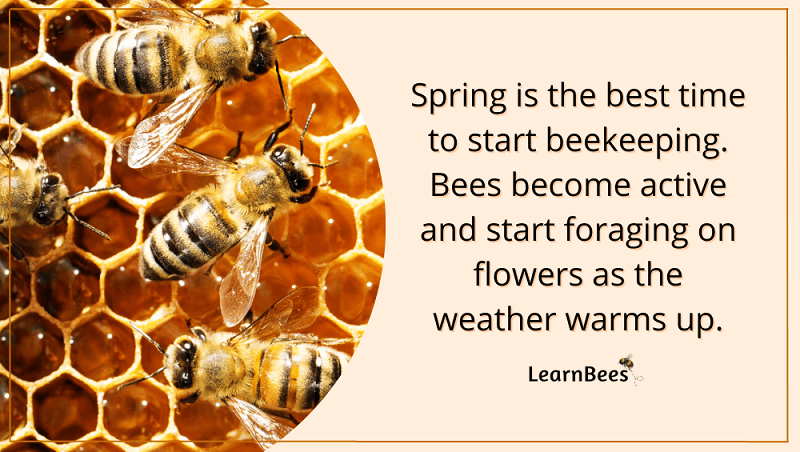
Spring is the best time to start beekeeping. This is when bees become active and start foraging on blooming flowers.
With that in mind, there are a few things you should do in the winter to prepare for your spring hives:
- Learn as much as you can about honeybees. If I’ve said it once, I’ve said it a thousand times. Beekeeping is not a hobby you should jump into blind. Read books about bees, watch YouTube videos, read articles, and get to know local beekeepers.
- Find a location for your hive. Honeybee hives do well when placed in the morning sun because it warms the bees up and gets them active for the day.
- Plant bee-friendly flowers. I’m a firm believer that every beekeeper should have flowers for bees. If you don’t, then you should ensure that you live next to plenty of flowers. Remember, flowers are a bee’s food source.
- Talk to your neighbors. Your neighbors should be aware that you’re joining the beekeeping hobby. You want them to feel comfortable with honeybees being next door. An open line of communication helps, so give them your phone number if they have any questions.
FAQs on Beginning Beekeeping Supplies
- What do I need to start my own beehive?
- How many boxes do I need to start beekeeping?
- How long does it take for bees to make a jar of honey?
- How much can you make from one beehive?
- Can you just leave a beehive alone?
- Is it OK to have just one beehive?
- How many pounds of bees do you need to start a hive?
- Is it expensive to start beekeeping?
- How much is a pound of honey worth?
- Can you start a hive with just a queen bee?
- Should you harvest honey from a first-year hive?
- When should you not open a beehive?
- How hard is beekeeping?
- How high should bee boxes be off the ground?
- How far should bee boxes be from a house?
What do I need to start my own beehive?
To start your own beehive, you’ll need the following:
- Bees
- A beehive with a stand
- A bee suit
- Gloves
- A hive tool
- A bee brush
- A bee smoker
—> Go back to the FAQs on beginning beekeeping supplies
More to Explore:
How many boxes do I need to start beekeeping?
You’ll need one brood box to start.
And as a general rule:
Do things one box at a time.
Once the bees have filled the box 70% full, then you can place a second brood box underneath it. You shouldn’t put honey supers on immediately because you want your queen to start rearing brood. This allows the colony size to increase, so there are more bees to collect nectar and pollen.
—> Go back to the FAQs on beginning beekeeping supplies
More to Explore:
How long does it take for bees to make a jar of honey?
In most cases, you can’t expect to collect honey from your new hive in the first year. You must allow your bees to establish themselves and build their stores.
But once they’re settled in, you should start getting some honey in the second year.
—> Go back to the FAQs on beginning beekeeping supplies
More to Explore:
How much can you make from one beehive?
I’ll shoot straight with you. Most beekeepers don’t make a profit on their hives. In fact, most beekeepers are in the hole because they spend more than they make.
This isn’t to say you can’t earn a profit, but you shouldn’t get into beekeeping for the money.
If you have patience, then beekeeping is a hobby that can pay for itself, but you’ll likely not see a turnaround in investment for a few years.
—> Go back to the FAQs on beginning beekeeping supplies
More to Explore:
- How Many Bees Are in a Hive?
- What is Backyard Beekeeping?
- Honey Extractors 101: Everything You Need to Know
Can you just leave a beehive alone?
If you want bees to be wild, then don’t capture them in the first place. Don’t buy bees, and don’t catch swarms.
For example, if you live in a rural area, and your neighbors wouldn’t be disturbed by swarms, then you might get away with that. But that would be a very bad idea if you live in an urban area.
—> Go back to the FAQs on beginning beekeeping supplies
More to Explore:
Is it OK to have just one beehive?
Yes, it’s fine to have only one beehive. We recommend that beekeepers start with no more than two hives so they don’t overwhelm themselves.
—> Go back to the FAQs on beginning beekeeping supplies
More to Explore:
- How Many Brood Boxes Should I Start With?
- How to Identify and Handle Queen Cells
- What is Festooning?
How many pounds of bees do you need to start a hive? How many bees do you need to start beekeeping?
We recommend a three-pound package, which contains about 10,000 honeybees.
—> Go back to the FAQs on beginning beekeeping supplies
More to Explore:
Is it expensive to start beekeeping?
Beekeeping is an expensive hobby to start, so you should do your research before making the investment. Be prepared to budget anywhere from $300 to $1,500 to get started, depending on your setup.
—> Go back to the FAQs on beginning beekeeping supplies
How much is a pound of honey worth?
A pound of honey is typically worth between $5 – $10. This varies depending on the type of nectar the honey was sourced from. For example, people may be willing to pay more for blueberry honey than clover honey. Blueberry honey is rarer, so the price and demand may be higher.
—> Go back to the FAQs on beginning beekeeping supplies
Can you start a hive with just a queen bee?
No, queen honeybees rely on worker bees to build comb, take care of the baby bees, and forage for food. A single queen cannot start a beehive on her own.
—> Go back to the FAQs on beginning beekeeping supplies
Should you harvest honey from a first-year hive?
No, as a general rule, we recommend that you don’t harvest any honey from your first-year hive. The bees need time to establish themselves and build up their stores.
If you harvest honey when the bees aren’t established, you could kill them by taking their winter food storage.
—> Go back to the FAQs on beginning beekeeping supplies
When should you not open a beehive?
In most cases, you should avoid opening the beehive during the winter – unless the bees are low on food and need your help. If that’s the case, you should research how to feed your bees during the winter properly.
—> Go back to the FAQs on beginning beekeeping supplies
How hard is beekeeping?
Beekeeping takes a lot of time and effort, but it can be very rewarding. If you’re not willing to put in the work, then it’s not a hobby for you.
You should also keep in mind that beekeeping is an unpredictable hobby. Many things can go wrong, and even experienced beekeepers lose hives.
If you’re not prepared for the challenges, then beekeeping might not be the right hobby for you.
—> Go back to the FAQs on beginning beekeeping supplies
How high should bee boxes be off the ground?
Beehives should be at least 18 inches off the ground to deter critters like ants or rodents.
—> Go back to the FAQs on beginning beekeeping supplies
How far should bee boxes be from a house?
You should place your bee box at least 25 feet away from your home and your neighbor’s home. However, the more space, the better.
